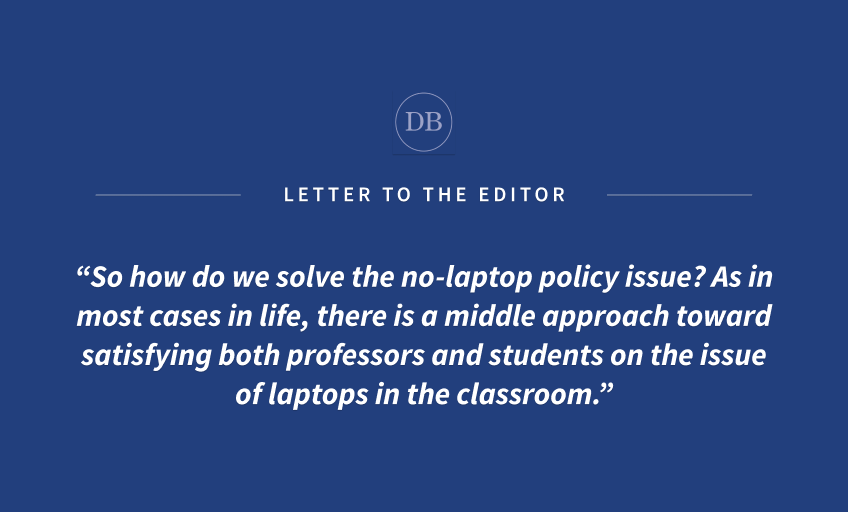Letter to the editor: Classrooms should allow different learning strategies, flexible screen policies

By Salvador Vazquez
Nov. 10, 2021 9:34 p.m.
Alexandra Kaiser’s column “Opinion: Limiting technology in the classroom stunts academic growth” brought up many valid points on how professors and students at UCLA feel about laptop policies in the classroom. Our research in a UCLA undergraduate class supports many of her points but also adds new information. Our interpretation of the research also differs on certain points from Kaiser.
As a teaching assistant for Psychology 133G: “Culture and Human Development,” I collaborated on a three-year research study led by my fellow TA at the time, Laura Rhinehart, and the course instructor, Patricia Greenfield of the psychology department.
While writing our manuscript on the impact of screen-free zones in an undergraduate psychology classroom, we discovered the findings on whether handwriting is better than typing are mixed, as Kaiser states. However, many of the so-called benefits of having laptops in class focus on student behaviors in the classroom such as typing faster and looking something up online. These are important. However, our study adds a focus on learning and cognitive processes.
Kaiser was correct in stating that students do in fact capture more information when typing, but counterintuitively, studies suggest handwriting notes is beneficial precisely because it is impossible to capture information verbatim. Although a precise mechanism for how this works is not yet established, research indicates typing notes verbatim may be a very passive learning approach, whereas handwriting requires more active processes such as paraphrasing, summarizing and making rapid associations. Making these associations just happens to be a part of acquiring and updating knowledge that is necessary for developing expertise on a subject.
An even better approach might be a combination of the two that involves some sort of audio recording plus handwritten notes. But as Kaiser previously mentioned, not all professors allow lectures to be recorded, and this strategy would only be better if students listen to the lectures again to amend the notes they already took in class. This requires a lot more time and effort, and research indicates humans generally choose the path of least resistance.
We arrive then at the issue of students already having the best knowledge of what works for them and not following through. On average, university students often choose not to engage in learning practices that are effective for learning. Why? Because they are hard and require more effort than more passive forms of learning. The research states effective learning is more likely to occur when it is challenging and requires effort. Study strategies such as highlighting, rereading text and rewatching lectures without note-taking are very common on college campuses but require little effort and lead to little actual learning. Strategies such as creating questions out of the reading and lectures and using those questions to study the material can be more effective for learning. So despite students knowing what is best for them, few follow through with effective strategies.
So how do we solve the no-laptop policy issue? As in most cases in life, there is a middle approach toward satisfying both professors and students on the issue of laptops in the classroom.
Our study found, as Kaiser articulated, that college students do not like to be told what to do, especially in situations in which personal freedoms are perceived to be impinged upon. Our first study involved sending students who wanted to continue using their laptops to the back of the classroom, and students clearly stated they did not like this on course evaluations with one student stating, “PLEASE get rid of the no-laptop policy! We are all adults.” The professor’s numerical evaluations also declined. However, a year later in the same class, when screen and screen-free sections were split side by side with screens allowed on the left of the class and no screens on the right, students did not mention the policy in course evaluations and the professor’s ratings increased.
Despite student pushback during our first study, students in the class with the screen section at the back scored 4% better on their final exam when compared to the class the year before that did not have a screen policy. Results from our second study were more compelling. Students who sat in the screen section the entire quarter were among the lowest-scoring on the midterm and final exams, while those who sat in the screen-free section all quarter were among the highest-scoring on both exams. Even more compelling was students who switched mid-quarter from the screen section to the no-screen section saw a 4% grade increase on their final over their midterm, larger than any other group in the study. While 4% may not seem like much, it can mean the difference between a B-plus and an A-minus.
There is also the issue of students who require accommodations, and we believe having a choice to sit in either screen or screen-free sections would better preserve privacy in these situations.
So based on our study with UCLA students, it is best to give students the option to choose and for the professor to split the class into a side-by-side screen section and screen-free section. This approach solves several issues by giving students a choice, promoting learning strategies that have a positive effect on learning and allowing those who choose not to use a laptop to not be distracted by screens being used near them.
Therefore, I agree with Kaiser that a flexible screen policy, such as the one examined in our study, is the best approach. I would argue focusing in class does depend on the student; however, it also depends on the method.
Vazquez is a doctoral candidate in the Human Development and Psychology division at the UCLA School of Education and Information Studies where he is currently serving as the Teaching Assistant Consultant for first-time TAs.

